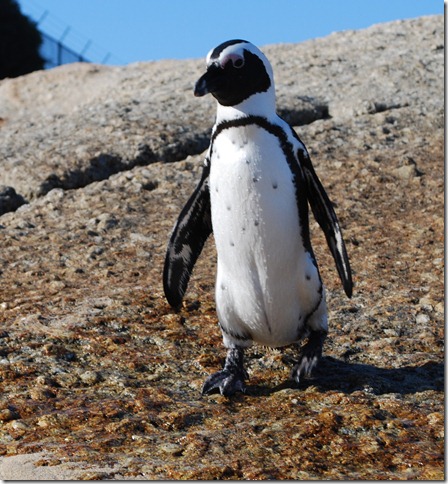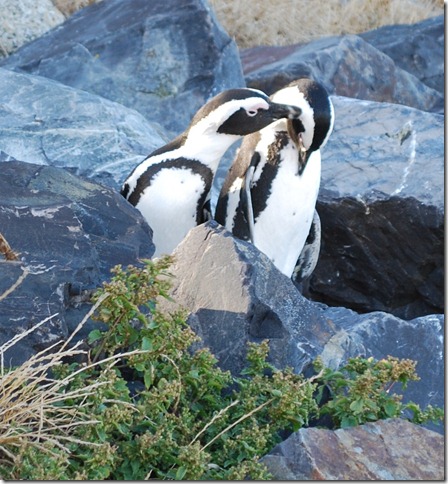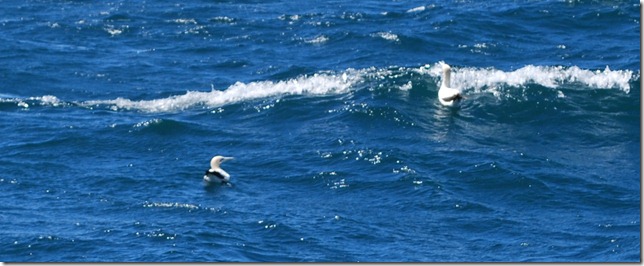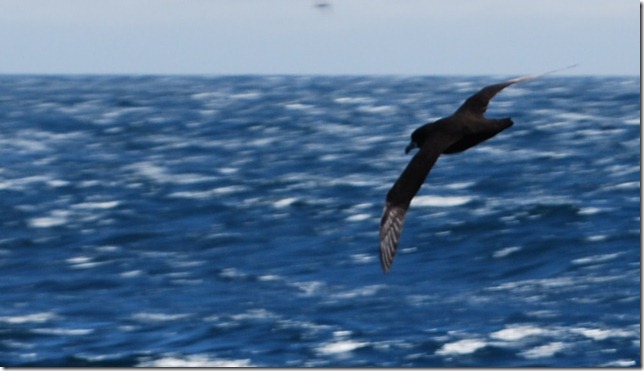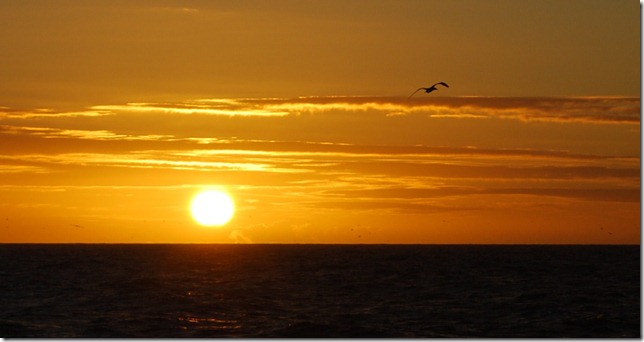It’s easy to blog when our life is filled with the adventure we’ve become accustomed to, but we’ve been fairly boring the last few days. We’ve settled down nicely here at Simon’s Town and have been anything but adventurous. We’re enjoying a bit of “normal” land-like life for a bit. We even have a membership at the local movie rental shop.
Simon’s Town came well-recommended to us by a couple of South Africans and we haven’t been disappointed. It’s a small, walkable place with two pubs, a “historic mile”, numerous shops, a couple of backpackers’ hostels, and a few corner stores. Seals swim and play in the marina and along the rocky shore, and a stretch of shoreline called Boulders Beach is home to a penguin colony. There’s one robot (traffic light) in town that’s just there to allow pedestrian crossing across the main street that runs along the waterfront on a narrow strip of fairly flat land between the steep mountainside and the bay. It’s a pretty safe place, the pace of life feels very relaxed here, and people not only have the time to talk to you, they actually seem interested in you and want to chat. Families are often sunbathing and braaing on the yacht club lawn with kids playing in the cold, fairly clear water, climbing up onto rocks, jumping off the footbridge and swimming platform, swimming through swaying kelp, and paddling kayaks. The town’s most famous resident is a dog called Just Nuisance that lived here during WWII when Simon’s Town was an often-bustling naval town. He was formally made a member of the Navy in order to allow him to ride the train and carry out his desire to always be around the town’s seamen. There’s still a Navy base here with a few seamen in uniform wandering the streets, but the two modern-looking Navy ships here haven’t moved once since I arrived and the flashing Christmas lights still strung about the top decks would seem to indicate that they aren’t going anywhere soon.
The prices here are a bit higher than Durban, but they’re still a good enough bargain that we ate delicious wood-fired pizza from the same great restaurant three days in a row. On the third day I promised the waitress that we wouldn’t come back the next day, so we ended up down the street for dinner at a combo sushi/Italian place for what else, sushi and pizza. Lauren loves sushi, and it’s not an easy find in many places we visit, so having a sushi place across the street where I can get a pizza as well is really something to take advantage of.
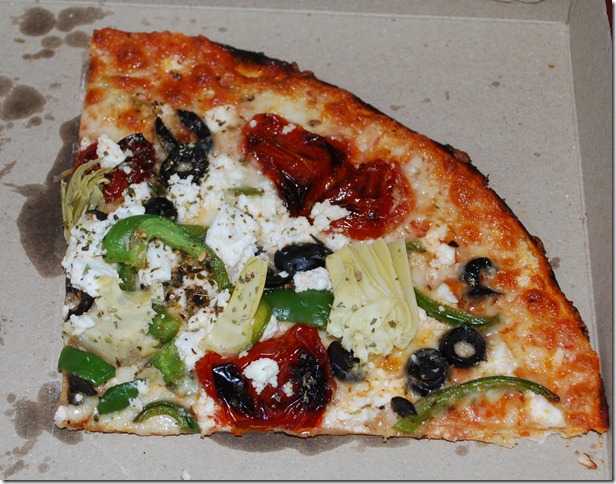 A still life for all the cheap, gourmet pizza lovers like us
A still life for all the cheap, gourmet pizza lovers like us
Our Swedish friend Jonatan from S/V Marionette came by the other day, and we enjoyed a relaxing day chatting and hanging out at Boulders Beach soaking up some sun and photographing penguins. There is a colony of about 3,000 jackass penguins here, and we were able to get pretty close to about 20 of them hanging out on some rocks at the edge of beach. Even though they can mangle a finger pretty badly if you get too close and try to feed them by hand, their jackass name doesn’t come from their behavior. I actually didn’t know they were called jackass penguins until later, but as soon as I heard the name it was obvious where it came from. They make loud, strange sounds, and the end of it, it sounds a lot like a donkey braying. I was commenting about how much they sound like a donkey before I even know about their name, and it’s clear whoever “discovered” and named them was thinking the same thing.
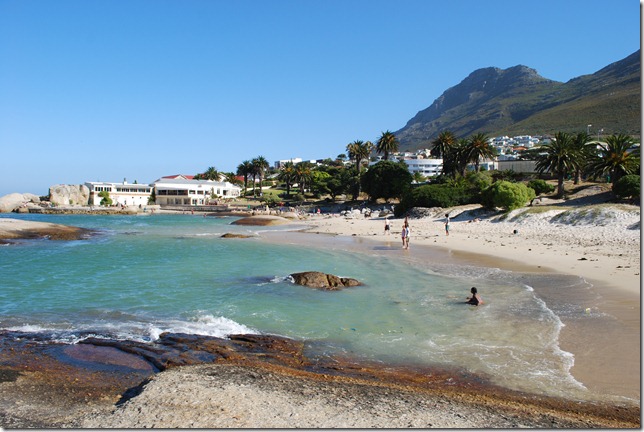 Doesn’t look like a penguin beach does it?
Doesn’t look like a penguin beach does it?
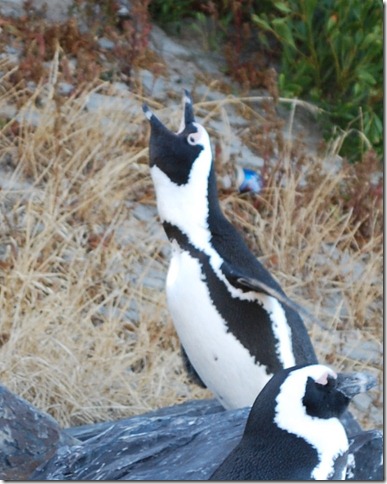 Making the donkey sound is a full-body effort for these little guys
Making the donkey sound is a full-body effort for these little guys
They are sort of fun to watch, although they weren’t incredibly active while we were there. Their combined solitary behavior, standing alone and well apart from each other, with social behavior like cleaning each other, “kissing” while hidden behind the rocks, and taking walks/swims together. Their walks are fun to watch as well due to their short legs. They can waddle/walk if the ground is fairly flat or gently sloping, but due to their short legs, even small discontinuities require them to jump or hop, which is pretty cute or comical, again because of their short legs (imagine Will Ferrell trying to hop up some steps with his legs tied together down to the ankles and both knees locked). I don’t know if penguins hold the record, but they have to be very near the top in terms of leg length relative to total body height for an animal that stands and walks upright. They make a dachshund look like a leggy cheetah.
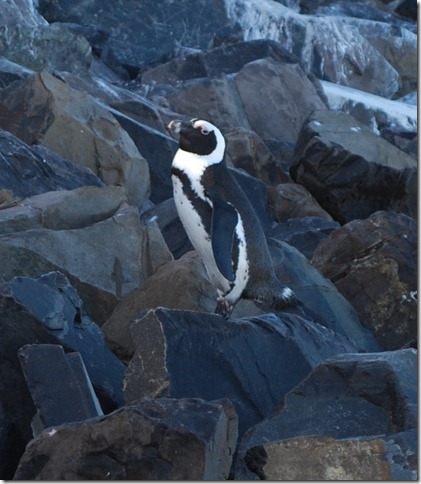 Typical jackass penguin action shot
Typical jackass penguin action shot
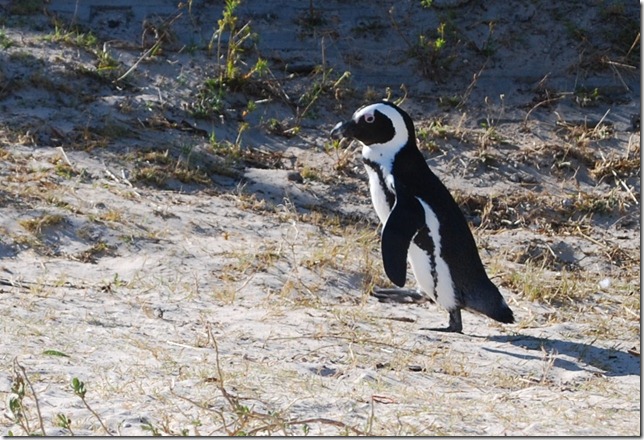 This high-stepper should be featuring in Johnnie Walker’s “Keep Walking” campaign
This high-stepper should be featuring in Johnnie Walker’s “Keep Walking” campaign
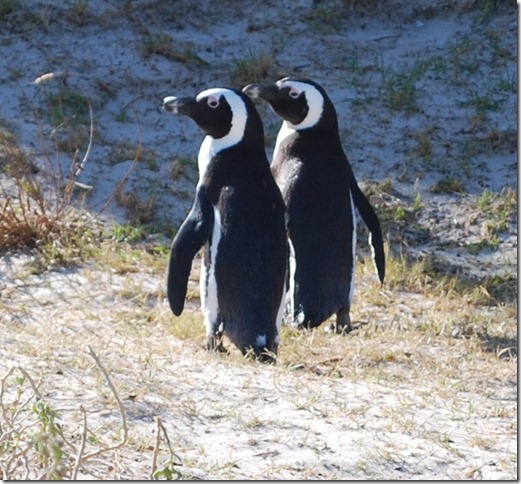 Lauren’s off to the left (apparently penguins also notice the pretty girl on the beach)
Lauren’s off to the left (apparently penguins also notice the pretty girl on the beach)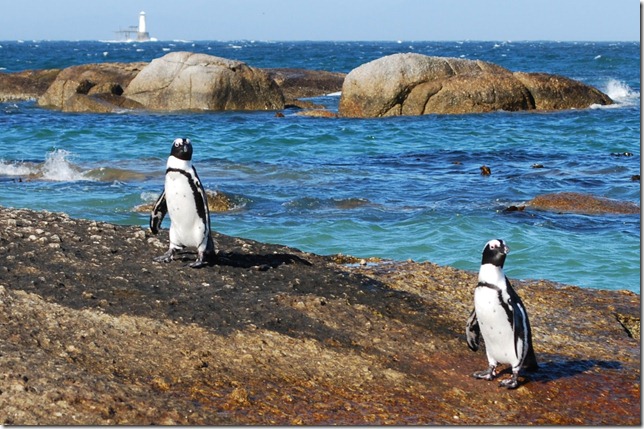 Sunning a bit after a swim
Sunning a bit after a swim
After a nice long break, I’m trying to get back in the routine of doing boat work as the time to leave and cross the Atlantic is fast approaching. So far I’ve done a better job of calling people to help with jobs I can’t do than tackling the long list of stuff I need to do myself, but at least it’s a start. Today we had a couple of rusty motor mounts on the starboard engine replaced, the scratch I put on the hull on the way in has been repaired, and a really nice German woodworker is about finished repairing one of our ailing hatch trim pieces. I do have to put in a good word for Clyde at Texwise in Durban just in case any other sailors are reading. Clyde did a lot of canvas-type work for us and was a pleasure to work with. Unfortunately, virtually all of the snaps on the new suncovers started rusting badly within two days of being installed. I gave Clyde a call a couple days ago to tell him about the problem and he immediately admitted to getting a bad batch of snaps that had rusted on another job as well. He told me who to call here in Simon’s Town to have them replaced and is having the bill sent directly to him. So cheers to Clyde for standing behind his work as well as being a nice guy in general.
After a joyous and much-needed reunion with friends and family, I am reunited with my husband in South Africa! With his newly clean-shaven appearance, you’d hardly know that Dallas just rounded the Cape by himself!
He picked me up from the airport in Cape Town late on the night of the 30th, and we enjoyed a bit of luxury in a nice hotel near the waterfront for the next two nights. This was practical since we wanted to be in Cape Town proper for New Year’s (and the boat is in neighboring Simon’s Town), and it also allowed me to gradually reenter the adventurous but much more rugged lifestyle of the cruiser. A mere two weeks in Johnson County is enough to remind one of those little pleasantries like dishwashers, hot showers, and spacious homes along with greater comforts such as access to old friends and a mother’s hug! But with that said, I’m happy to be back aboard Pura Vida and eager to see what the remaining months of our circumnavigation will bring.
Cape Town is a beautiful city. The architecture seems to be British-colonial, and many buildings in the central district are white or pastel. The most striking features (besides its extremely diverse population) are geographical, as both beaches and mountains surround the city. In particular, Table Mountain appears as a prominent backdrop by day and by night, at which time its features are illuminated from powerful lights along its base.
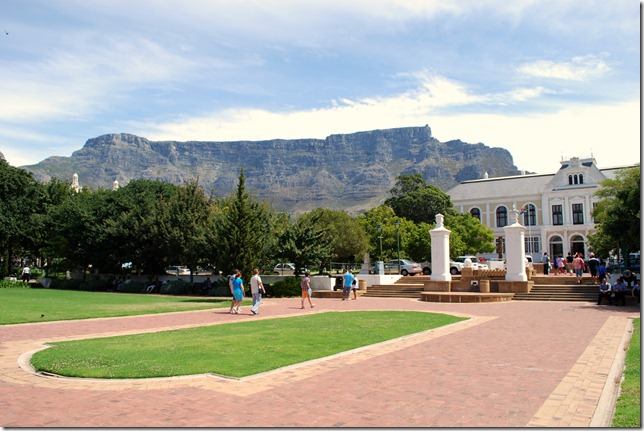 The Company Gardens in Central Cape Town with Table Mountain behind
The Company Gardens in Central Cape Town with Table Mountain behind
On the 31st, it was sunny and hot in CT, but due to a gale watch (not unusual here), the cableway ride up Table Mountain had been suspended, so we opted instead to spend the afternoon exploring the city by foot. We happened upon the National Gallery of Art, which was really amazing. Most of the exhibits were comprised of photographs taken somewhere in Africa, so you can imagine the kind of material that was involved – war, poverty, and tribal custom to name a few. From the gallery, we walked around Central CT and found a bite to eat in an al fresco cafe before heading back to the hotel to rest up for the late night festivities. Eventually we made our way over to the marina basin and joined several of our friends aboard S/V Itusca, the spacious and modern catamaran that our Brazilian friends are sailing around the world thanks to their sponsors. Around 11:30 we made our way over to a 188’ superyacht called Pangaea! Our friends aboard the superyacht Drumbeat managed to get us an invitation to the very exclusive party there, but I’m not sure that they were expecting a group of 14 young(ish) rabble-rousing cruisers! They allowed us to stay long enough to watch the midnight fireworks from the top deck before kindly asking us to leave. We weren’t quite ready for the party to stop, however, and walked around the waterfront area for a little while until one of our group befriended a small group of African ladies with a destination in mind. We followed them through the mayhem of Central CT to the Zulu Bar. En route we passed what appeared to be a one-sided fight in which a very wound up, heavy-set African women had left two large African men on the ground rubbing their heads and was attempting to pull herself away from the man restraining her to have a go at a third! All in all, it was a memorable but not TOO eventful evening, which is the way we like it these days.
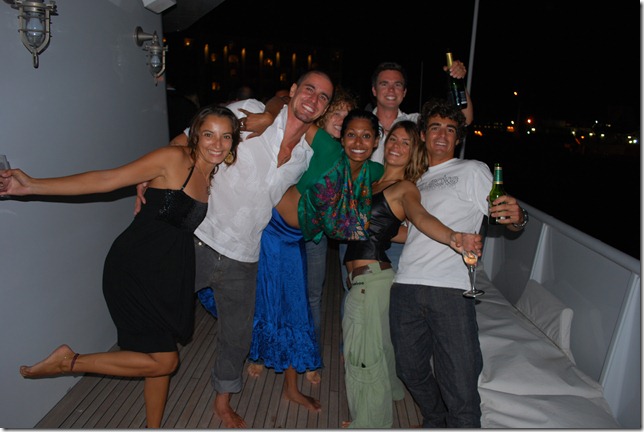 Who wouldn’t want this crew aboard?
Who wouldn’t want this crew aboard?
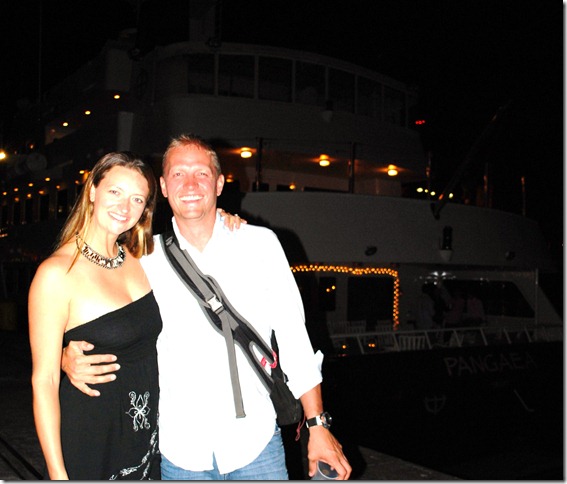 Still smiling after getting booted off of Pangaea
Still smiling after getting booted off of Pangaea
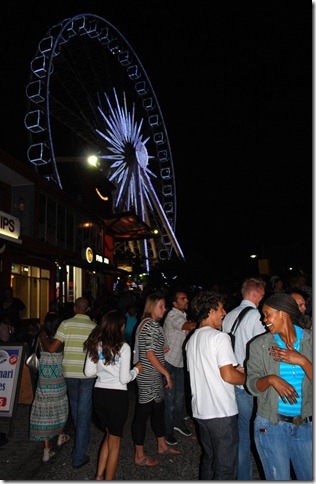 The scene at the waterfront just after midnight
The scene at the waterfront just after midnight
We got around slowly on New Year’s Day but eventually joined our American friend Nat from S/V Bahati along with his newest crew members from Maine for a trip in the cable car up to the top of Table Mountain. It was an ideal day for it – blue skies and not too much wind. As a result, we were not the only ones with the good idea to go up the mountain, and we had to wait in line for over an hour to board the cable car, but it was well worth it. The views were incredible, and the 5-minute cable car ride was quite an experience in itself. The car rotated 360 degrees, and toward the top of the mountain the speed with which we ascended, just a few feet from the steep rocky cliff face, was enough to make people squeal! Atop the mountain, we sat and enjoyed a beer and some good conversation with our friends overlooking the city and the sea. It is easy to see why the Table Mountain cableway is considered a must-see if in Cape Town.
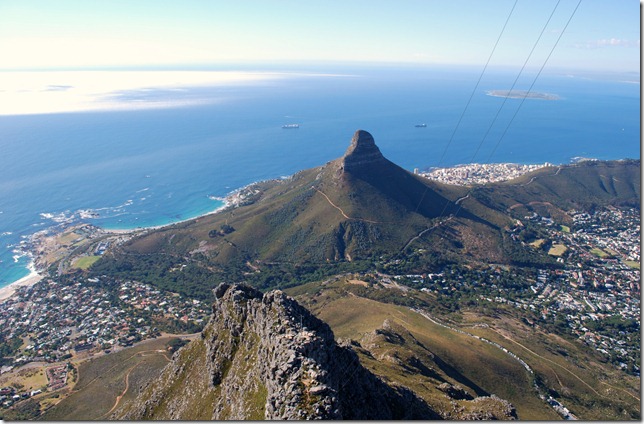 Overlooking Lion’s Head. Behind and to the right is Robben Island, where Mandela was imprisoned for so many years
Overlooking Lion’s Head. Behind and to the right is Robben Island, where Mandela was imprisoned for so many years
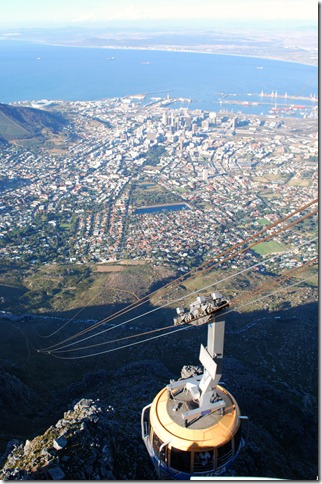 I enjoyed our transportation up the mountain, but next time we’re planning to hike!
I enjoyed our transportation up the mountain, but next time we’re planning to hike!
Today we returned to Simon’s Town and to Pura Vida. She’s looking good with her new trampolines and sun shades. It’s good to be home.
I made it! I arrived nearly all in one piece, but unfortunately I didn’t get in without a little more excitement than I wanted.
Since leaving Durban, I’ve sailed nearly 800 nm, spending six nights at sea with just the one stop in East London. I really got lucky on the second weather window that let me sail the 530 nm from East London to Simon’s Town non-stop. It seemed to be an especially long window, the forecasting was excellent, and I was able to put together an approach to the passage based on the forecast that left me with a little motorsailing, but never having to deal with contrary winds or any really bad conditions.
Rounding the cape was a little anti-climactic. It was a cool feeling, but at the time I would gladly have traded it for a warm shower and a nap. Sailors always joke that anything with the word “Cape” in it means trouble, but although it was windy, and the seas were a bit rougher there, it was nothing like the harrowing stories of rounding the cape in a gale from the old days of tall ships. It also seemed a little strange sailing past it by myself. Voyaging around one of the world’s southern capes is still sort of a big deal for sailors, so it seemed a little strange to be doing it by myself when this trip has been such a joint effort. For me, it was a time to think about Wes and Lauren, the two people who have had the most to do with this trip. Wes and I learned to sail together back in Houston aboard our Catalina 30, he kept the dream alive with a string of great charter trips in Florida and the Bahamas after we sold our boat, and he partnered on this trip as well, sailing with us from the US to New Zealand. Lauren’s shared the dream (and the reality) of this trip since day one and I’m really looking forward to her return (only 2 more days now!).
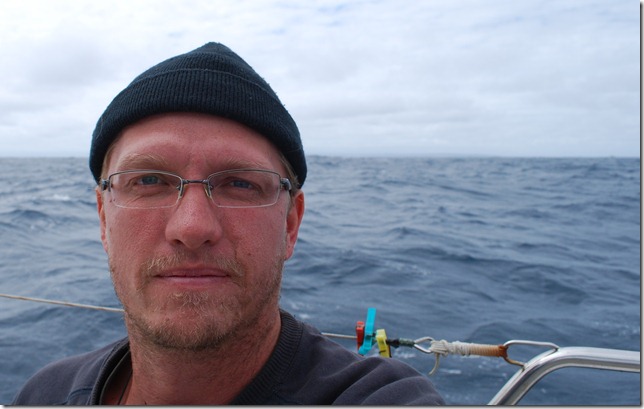 Rounding the southernmost point of the African continent – Cape Agulhas. This one’s dedicated to the original Pura Vida crew: Wes, Tiff, & Lauren.
Rounding the southernmost point of the African continent – Cape Agulhas. This one’s dedicated to the original Pura Vida crew: Wes, Tiff, & Lauren.
Just before rounding the cape, I crossed inside the main shipping lanes and headed farther inshore for the run up to False Bay. After that, I was free of shipping traffic, but closing with the coast also meant keeping an eye out for the shoreline, only a few miles away, and for several rocky banks. I had a chance to get a couple of hours of sleep by putting the boat on an offshore course that was well inside the shipping lanes, and two hours of sleep is like an eternity for me at this point. I woke up with so much energy that I cooked a meal, picked pictures for the blogs, did some emailing, and started writing this blog.
Unfortunately the energy from two hours of sleep doesn’t last forever. Right as I was entering False Bay and struggling to stay awake, the blow started. It must have gotten up to 30-40 knots and it was freezing cold – pants, two sweatshirts and my weathers still left me cold from the wind. The waves built as well, but I was able to roll the jib up and make 5-6+ knots on only a third of it. The cold helped keep me awake, but I was still tired enough that if I rested inside for more than 5 or 10 minutes I couldn’t keep my eyes open.
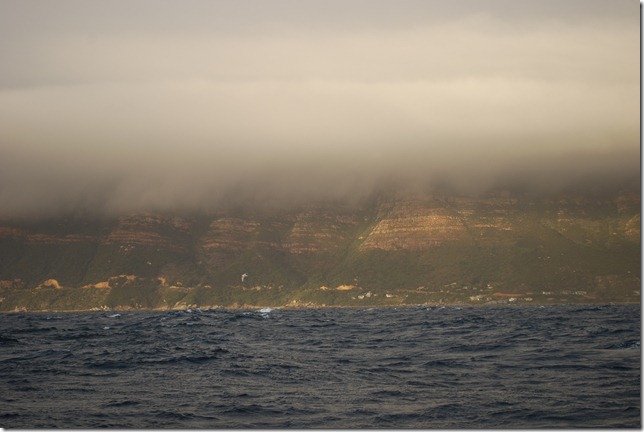 False Bay is a large, horseshoe-shaped bay open to the south and lined with rugged, mountainous terrain
False Bay is a large, horseshoe-shaped bay open to the south and lined with rugged, mountainous terrain
Everything went smoothly until it was time to furl the jib, start the engines, and come in. Right as I started rolling in the jib, it really started blowing – gusting over 40 knots. The port engine was slow to start in the cold, but eventually did. The starboard wouldn’t. With this much wind and a tricky spot to get into in the marina, I really needed both engines for maneuverability, so after several attempts to start the engine failed I headed down to the engine room. I figured it was just cold (we don’t have glow plugs) and there’s a good trick you can use if just heating up the cylinders by trying to start it doesn’t work. The problem is that you need one person to turn the ignition key (20 ft. away) and another to hold the decompression levers on all three cylinders until the engine is really spinning and then release the decompression levers, allowing the engine to fire. Luckily the ignition wire was conveniently set up for hotwiring, so I was able to hold the decompression levers and at the same time disconnect the ignition wire and manually short it to the +12V for the starter, sending sparks flying as the engine turned over, but on the second attempt it worked. I was pretty happy, because it was blowing a gale onshore, I’m not really set up for singlehanded anchoring, and I really wanted to get in and get some sleep and a shower.
Unfortunately, it was apparently a little early and nobody from the marina was answering the radio. Oh well, I figured I’d go ahead and go in and either flag someone down to help me with the docklines, do it myself, or turn around and go back out to wait. I did manage to flag down a confused but very helpful sailor named John, who had stuck his head out to have a smoke as I was coming in. The spot I had to get into was at the very beginning of the dock, next to a wall with other boats, with a strong tailwind, and for some reason, there was a mooring buoy floating right in the middle of the area between slips at that end, ready to foul the prop. Not exactly what I was hoping for, but I gave it a shot and came close. Unfortunately, it was a starboard side tie-up and we usually do port-side so that I can see the dock from the helm. Being unable to see the dock (and the dock having no corner protectors) I gave the starboard hull a pretty good scratch turning the corner. Oh well. Normally I’d be pretty bummed about it, but we should be able to get it sorted here and it’s not bad, all told for a passage from Durban to False Bay. So much for all the danger and excitement happening offshore.
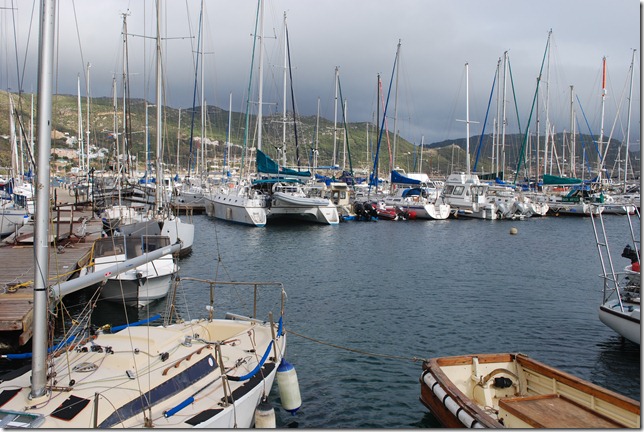 Doesn’t look tight from this angle, but sure felt that way with the wind howling, and why is there a buoy right in the way?!
Doesn’t look tight from this angle, but sure felt that way with the wind howling, and why is there a buoy right in the way?!
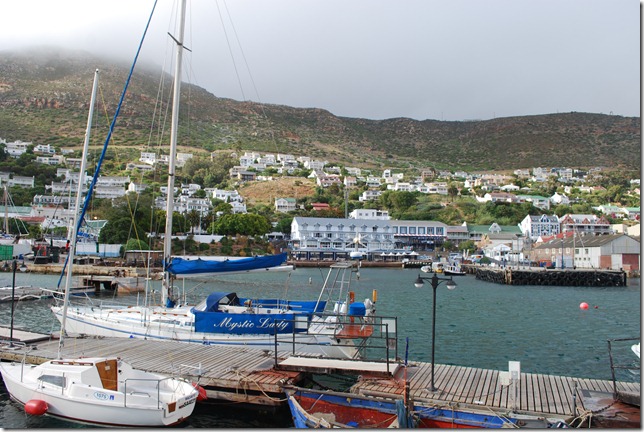 The quaint, colonial-looking waterfront ought to be fun to explore
The quaint, colonial-looking waterfront ought to be fun to explore
I didn’t mention it earlier, but we’re formally in the Atlantic Ocean now. Two down and one to go…
Lat: 35 07.137′ S
Lon: 20 43.302′ E
I didn’t think I’d have much to write about by myself out here, but I guess I was wrong. I’m emailing twice a day anyway to keep a close eye on the weather, so why not?
Last night was one to remember. There have been more seabirds here than anyplace we’ve been except maybe New Zealand. At sunset, they spread out over the ocean fishing for dinner. Hundreds of them, spaced well apart, covered most of the visible ocean surface. They fished by flying at a relatively low height, flying odd, swooping patterns at 50′ or less. When they spotted prey below, they immediately interrupted their flight with a direct dive down into the water. Sometimes they’d spotted something ahead and just nosed down into a dive, but at at other times the fish was beside or even just behind them and they turned into aerial acrobats, executing a quick combination of rolls, turns, and spins to point nose first at their target, then tucking their wings, they dropped with the force of gravity until they disappeared with a splash. As I sat watching them in the orange glow of the sunset, I could see the unmistakable plumes of spray from whales off in the distance.
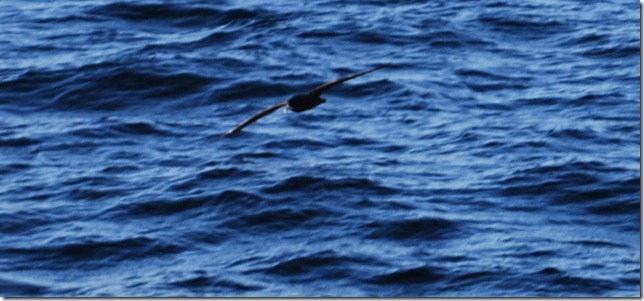 Some birds will dip a wing to skim the surface in order to scare or herd fish
Some birds will dip a wing to skim the surface in order to scare or herd fish
This far south during the southern winter the days are noticeably longer than in the tropics, and there was still a faint light from the sun left in the western sky at 9 pm. When it faded, and before the moon rose in the east, the sky was covered in a soup of stars. The Milky Way stretched across the sky and even common constellations were a little difficult to identify because of all the dimmer stars, normally masked by ambient light, that were shining brightly. Even 50 miles offshore, the water hasn’t turned blue here; it has a greenish hue and is rich with phosphorescent plankton. In the starry night, every whitecap or disturbance in the water became a glowing, frothy white. Behind me, the boat’s wake was two glowing streams of phosphorescence that stretched more than 60′. The hulls themselves created such a glow that it looked like that boat was made of fluorescent lights below the waterline. As we moved along through the crisp night air, it made me wish there was a way that you could capture a sight or an experience like this so that you could re-live it. But you can’t. All you can do is keep having new adventures.
Sailing is all about highs and lows — fighting not to puke while struggling to perform the basic necessities of life and sailing one day, and then staring in awe as you sit quiet and undisturbed the next day, taking in some of the planet’s most beautiful sights. Those highs and lows are a little more extreme when you’re singlehanding, but aside from the fatigue and loneliness, it’s much the same.
I just changed course and headed WNW for Cape Agulhas, about 40 nm away. The new northerly component will stay in our heading until we reach the US. It looks like I’ll round the cape in daylight today and reach Simon’s Town tomorrow.
Lat: 35 00.934′ S
Lon: 22 26.494′ E
Yesterday ended up being a pretty nice day weather-wise. The sun was out most of the day, seas were down, and it was cool, but not cold. Around dusk, the wind had dropped enough that boat speed was hovering around 4 knots, so I needed to do something. Normally I’d put up the spinnaker, but being singlehanded with night coming on, I decided to go for some motorsailing instead. The port engine had only been running a couple of minutes when I heard it start losing power, dropping RPMs, and beginning to die. I quickly shut it off, tried restarting it, and got the same result (not sure what I was trying to prove there). Off went the watch clothes, on went the work clothes, and I crawled down into the engine room with a headlamp. The transparent bowl at the bottom of the combination fuel/water and fuel filter had generous amounts of something that looked like mucus in it. I soon figured out that if I squeezed the manual pump fuel bulb I have in-line, more mucus-looking stuff would dump into the filter, but the engine would only run for a minute or two until I had to pump again, and it was starting to sound a little loud.
Ok. At least I know what’s wrong now — bad fuel and a clogged fuel filter. I’m usually pretty careful about fuel, but I have had a couple of incidents lately, with the port tank, that aren’t (or maybe are) characteristic of me. One was buying 5 gallons of fuel off Garth in Mozambique. He needed the cash and I could always use a little fuel, but I would normally only buy fuel from someplace I expected to have clean, fresh fuel. The second one was accidentally leaving the fuel fill cap off overnight after getting distracted while adding a jug of fuel in Durban near sunset. It sprinkled a little bit, but I don’t remember it raining too much.
Whatever the cause, I gave it up for the night and settled for 3-4 knots on the jib as the wind was too far aft to use the main. I didn’t want to run the other engine because one engine down is halfway to no engine at all, and I’d rather not push it. The effect of sleeping so little for a day and a half had caught up with me. Even with my watch being right beside my ear, it never woke me up once. I found myself waking up 1-3 times an hour, but never because the alarm was going off.
Luckily, the AIS seems to be working again, which makes things much safer. My current theory is that the problem was humidity messing up the AIS RF electronics, but we’ll see. I moved some canvas covers and rags that were getting wet so that now any moisture in that compartment drains out and it seems to have made a difference.
Here’s the basic math behind not getting run over (which did happen to a boat out here in the last year). Large ocean-going ships generally do 14-17 knots. Our speed is variable, but it’s not unusual to be doing 7 knots here due to strong winds or current. I’m essentially trying to cover the same route they’re covering, so they’re always coming up from behind or ahead. From behind, they’re closing at around 10 knots, which is slow enough for me to see them before anything can happen, but from ahead they’re closing at 24 knots or more sometimes. In good conditions (good visibility, calm seas, awake & alert person looking, and spending a bit of time looking and re-looking) you can spot the superstructure of a large ship at roughly 8-11 miles. Between 5-8 miles, the hull becomes visible, making it a much larger object on the horizon and one you’re not likely to miss. The issue is that at 24 knots, you’re getting a mile closer to each other every 2.5 minutes, or 6 miles closer between every 15 minutes check. It’s not uncommon to miss seeing a ship due to poor visibility, fatigue, a tanker’s low profile, etc. when it’s 6-8 miles away and then come back out 15 minutes later to find it right on top of you. If you miss one 15 minute check, a ship that wasn’t visible last time you looked can now be past you. This is where the AIS makes itself very useful. In addition to telling you exactly where each ship is headed and sounding an alarm if you’re on a collision course, it can see much farther than the naked eye, easily picking up ships 15-20+ miles out, giving you a warning time that’s much longer and letting you concentrate on the occasional ship that is going to pass close by instead of visually tracking every ship you see to determine whether it’s coming toward you. You can see why having it working again has been a big deal. The local fishing boats never seem to be fitted with an AIS transmitter, but they’re always well lit, generally aren’t moving too fast, and theoretically are keeping a good watch.
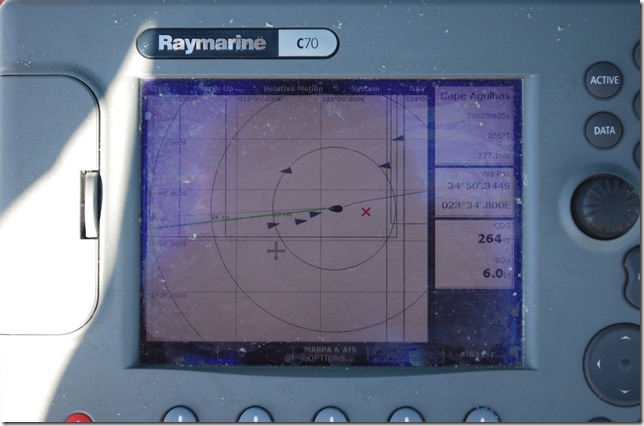 A common sight – half a dozen ships and three coming my way
A common sight – half a dozen ships and three coming my way
 For all the Hannibal, Palmyra, & Quincy folks – the Mark Twain loaded with containers the size of railway cars
For all the Hannibal, Palmyra, & Quincy folks – the Mark Twain loaded with containers the size of railway cars
After getting more sleep than anticipated, I was ready to tackle the port engine problem not too long after sunrise. I anticipated a lot of work filtering fuel, making a small clean-fuel tank from a jerry can, and bleeding the engine, but I started by draining the filter/separator and immediately saw the problem — the thing was almost entirely filled with water!. Fuel floats on top of water, and there’s a transparent bowl at the bottom of the filter where the water collects. You should see a line between the two liquids if any water is present and if so, you can open a nipple at the bottom that lets the water drain out from the bottom. This is part of the engine check I do before each passage, but somehow the bowl had gone from no water to completely full of water, evidently between Durban and here, so that I never saw a line and realized it needed to be drained. In all, the contents of the filter were 80-90% water. No wonder the engine wasn’t happy. I have a case of fuel filters on hand for just this sort of emergency, and after flushing and cleaning the filter housing, replacing the filter element, and bleeding the air from the fuel lines, it eventually started up. It had a bit of white smoke in the exhaust for a minute or two, but then ran fine for over an hour and sounded as good as ever.
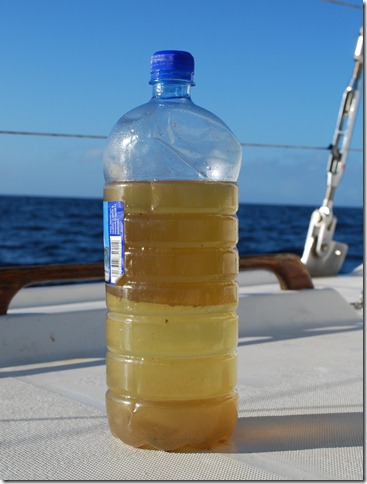 Filter contents: bottom half water, top half fuel (most of the fuel was from flushing, not the filter drain)
Filter contents: bottom half water, top half fuel (most of the fuel was from flushing, not the filter drain)
Within a couple of hours, the wind started to pick up a little bit and since then I’ve been doing 5-7+ knots on a beam reach with the full main and jib. The morning was clear again, warmer than yesterday, and the seas were pretty calm. This afternoon some low cloud cover rolled in, but the seas have stayed calm. I’ve sailed a course that’s almost 50 miles offshore now so that as the wind comes from the SSE and strengthens I’ll still have it aft of the beam as I near Cape Agulhas. It’s hard to say what my timing will be like at this point, but it looks like there will be a pretty good blow from the SE/SSE once I round the cape (I’ll be going NW then so should be fine), so I’m guessing I’ll make Simon’s Town in less than 48 hours.


